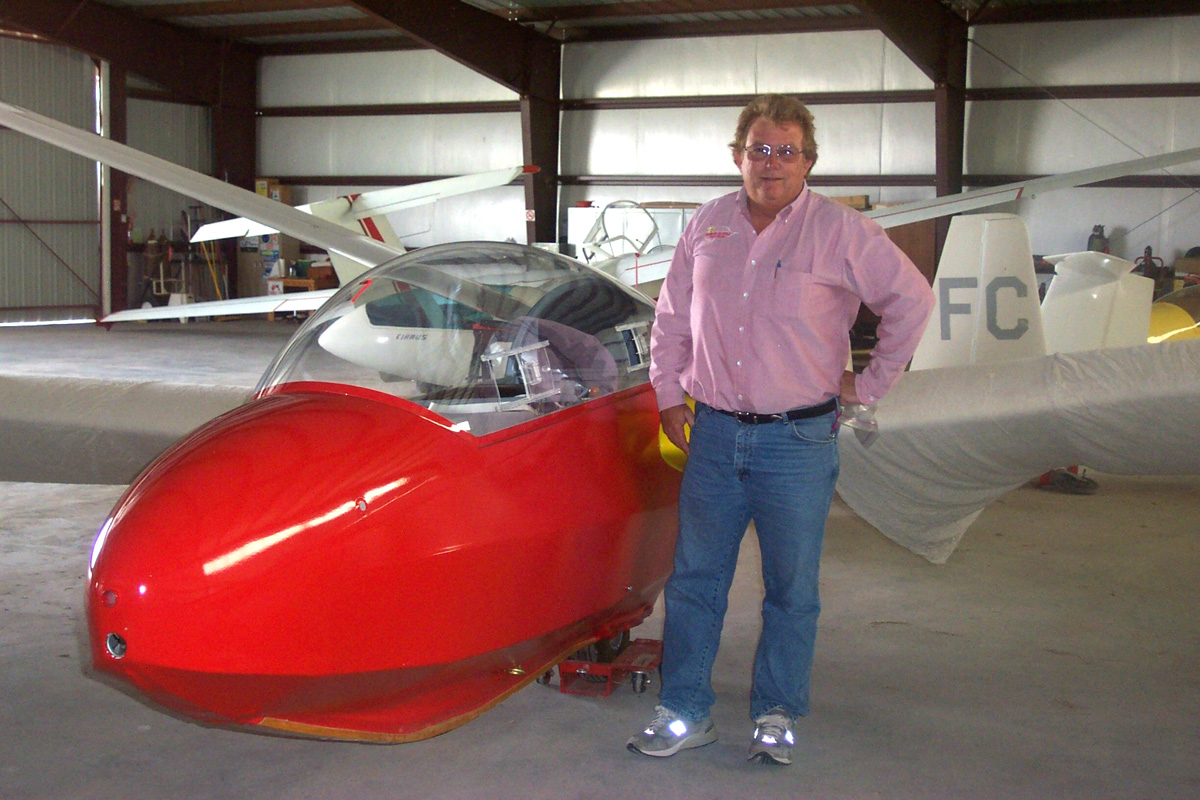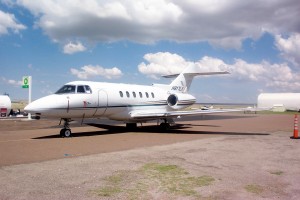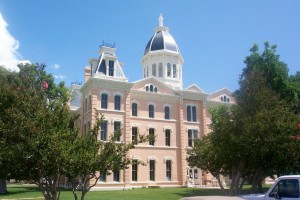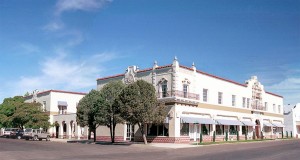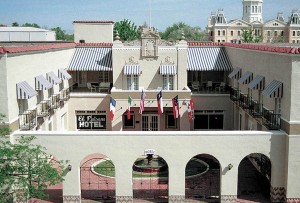By J Carpenter, reprinted by permission of Texas Department of Transportation Aviation Division
Marfa, Texas, is located halfway between El Paso and Del Rio, in the majestic Davis Mountains of West Texas. At 5,000 feet above sea level on the Marfa Plateau, one enjoys mild summers and pleasant winters. Today, Marfa is a famous tourist attraction. People explore the remote desert mountains, visit the local art galleries and pursue the increasingly popular sport of soaring. The city is the site of the 1970 World Soaring Contest and of the filming of the soaring film, “The Sun Ship Game.”
Marfa Gliders, located at Marfa Municipal Airport (MRF), provides services ranging from glider rides, flight instruction and rating certifications. Owner Burt Compton and his wife, Kathie, were married in a glider high above the airport. Each year, the couple sponsors the “Burt & Kathie Compton Aviation Experience Scholarship,” designed for qualifying Marfa High School students.
Compton is a master flight instructor and Federal Aviation Administration designated pilot examiner. In 2007, the Lubbock FAA Flight Standards District Office selected him as Flight Instructor of the Year. According to Compton, Marfa’s location and terrain provide near perfect conditions for gliders. Gliders don’t have engines, but instead have long wingspans that provide exceptional lift. A motorized aircraft tows the glider into the air. At about 2,000 feet, the glider releases the towline and is then on its own to maintain altitude. It will cruise at 50 to 80 knots, searching the sky for thermals. Because of the numerous updrafts in the area, the glider pilot can get a free ride upward by circling in these rising columns of air.
“A trained pilot can maintain altitude for hours,” says Compton.
The updrafts are so favorable that many times a pilot can maintain altitude all day long, burning no fuel, using wind power alone.
Looking from his hangar door, Compton pointed out several isolated, billowing, cumulus clouds west of the airport.
“Beneath each of those clouds are updraft thermals,” he said. “We seek out those areas to gain lift from the thermals.”
Compton explained that even on days with no clouds, glider pilots are able to identify thermals uplifts by observing soaring turkey vultures.
“We often share the same airspace as our buzzard cousins, in order to maintain altitude,” he said.
Compton says a glider pilot can climb to altitudes as high as 14,000 feet above mean sea level.
“The record is 49,000 feet,” he says. “On cross-country contests, pilots can often fly distances of 1,000 miles and more in a single flight. It’s called ‘wave flying,’ where a ridge of air pressure is formed along dry line boundaries that often start at the Marfa Plateau and can reach as far north as Canada. The questions for the soaring pilot are, ‘How high in altitude? How long in hours? How far in distance can we go?'”
More to do in Marfa than soaring
Marfa Gliders also offers advice on family adventure activities, horseback riding, stargazing and art galleries. The first Spanish explorers came to this area in the early to mid-1500s. Two missions were constructed near an area they called La Junta de los Rios, “the junction of the rivers,” one of which is the Rio Grande. The missions were erected near where Presidio, Texas, is located today.
In the 1850s, after a threat from Mescalero Apache uprisings, a settlement was developed in an area 80 miles to the north of La Junta. The settlement was named La Limpia, located on a creek by the same name. To protect the settlement, U.S. Secretary of War Jefferson Davis established an Army post in 1854 called Ft. Davis.
From 1880 to 1890, cattlemen seeking new territory to graze their herds precipitated the surge of growth in Presidio County. This, combined with the birth of silver mining operations and the extension of the railroad, brought stabilization to the area. The railroad reached “Tank Town,” which was little more than a watering stop with three buildings: a hotel, stable and gambling hall. The name Marfa was derived from a female character in “Brothers Karamazov,” a book by Fyodor Dostoevsky. A railroad engineer’s wife was reading the book as they arrived at the water stop, and she named the town.
Because of its remote location, driving to Marfa can take a long time. The nearest major airports are in El Paso and Midland, both nearly 200 miles away. Therefore, MRF plays an important role as the gateway to this social center and nearby Big Bend National Park. Although called Marfa Municipal Airport, the facility, which was built in 1979, is actually owned by Presidio County. A permanent fixture of the airport is operations manager Ron Lewis, who meets and greets visitors flying into the area. Lewis can provide fuel, aircraft maintenance and car rentals. Since he lives at the airport, great service is only a phone call away and available almost any time of the day.
Runways 12 and 30, at more than 6,000 feet long, can accommodate even the largest business jets. Runway 30 has both GPS and VOR approaches. With the development of the artist community and other attractions, many business jets arriving from all around the world visit this airport.
“Approximately four jets arrive and depart each week,” Lewis said.
For a town with a population of only a couple of thousand, that’s a lot of jet traffic!
“On several occasions, we’ve had Charles Schwab and his family arriving from New York in his Global Express,” Lewis said. “When the Chinati and Judd foundations host their annual open house during Columbus Day weekend in October, we’ll sometimes have 20 to 25 jets from all over the world visiting at one time. Those pilots can have delays getting air traffic control clearance when they all try to leave at the same time.”
The Chinati Foundation is a nonprofit contemporary art museum located on the edge of town. Founded by the late artist Donald Judd, it opened to the public in 1986. It was Judd’s goal to bring art, architecture and nature together, in order to form a coherent whole. The foundation preserves and offers large-scale, permanent installations by a limited number of artists. Originally conceived to present installations by Judd, Dan Flavin and John Chamberlain, the museum’s permanent exhibitions include works by Carl Andre, Ingolfur Arnarsson, Roni Horn and Ilya Kabakov. Throughout the year, the museum hosts temporary exhibitions as well. This museum is one reason so many business jets land at Marfa Municipal Airport, especially in October, for the annual open house.
Interns work closely with the Chinati Foundation museum professionals and gain valuable experience for future courses of study and careers in museum and arts administration. Since interns are the museum’s primary contact with the public, they have the opportunity to interact with visiting scholars, artists, architects and members of the press.
The Chinati Foundation also features children’s summer art classes, which started in 1992. The program is designed to meet the needs of area schoolchildren in the first through ninth grades. Each summer, experienced instructors from Texas and other areas around the world teach the series, drawing upon the foundation’s collection and facilities to enrich classroom and studio activities. Supported by the Texas Commission on the Arts, the art classes are free.
A growing center for artists, Marfa boasts several art galleries with worldwide acclaim, such as the Greasewood Gallery, located in El Hotel Paisano. This gallery features paintings by Bill Barnett, Janet Jackson and Kathleen Squires, plus photographs by Rich Fenker.
Tourists are also attracted to Marfa to see popular landmarks of the area. In 1930, El Hotel Paisano was built and became one of the significant features of the town. It’s located just south of the beautiful Presidio County Courthouse. The hotel’s greatest moment came when it housed members of the cast from the movie, “Giant,” filmed in 1955. The cast included Elizabeth Taylor, James Dean, Dennis Hopper and Rock Hudson.
The hotel features charming rooms, meeting areas and facilities, such as “Jett’s Grill,” named after the infamous oil tycoon Jett Rink, portrayed by Dean in “Giant.” During the filming, the cast and crews watched the dailies in the ballroom. “Giant” is now shown regularly at the hotel.
In 1979, El Hotel Paisano was admitted to the National Register of Historic Landmarks. James Dean’s hotel room is the most popular for today’s guests.
Adding to the popular attractions of the region are the “Marfa Lights,” sometimes called the “Marfa Mystery Lights.” These strange phenomena are unexplained lights, or “ghost lights,” usually seen near U.S. Route 67, on Mitchell Flat east of Marfa. The first confirmed report of the lights dates to a 1957 magazine article, but earlier oral reports have been attributed to Robert Reed Ellison, back in 1883.
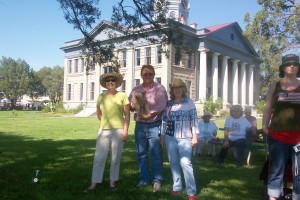
L to R: Jeanne Carpenter, Burt and Kathie Compton wait in front of the Davis County Courthouse for the July 4 parade at Ft. Davis, Texas.
Some say they’re ball lightning or plasma generated by geological forces deep inside the earth. Others claim they’re actual ghosts of Indians that once roamed the area.
Scientists have studied the phenomena, but haven’t agreed on a conclusion. Skeptics attribute the lights to mistaken sightings of ordinary nighttime lights, such as distant vehicle or ranch lights or astronomical objects. Lewis says that the lights have become so popular that 20 to 30 cars show up each night at a roadside viewing station erected by the Texas Department of Transportation, along Route 67 a few miles east of Marfa.
Annual events in the Marfa area include a July 4 fireworks show, Big Bend Hall of Fame Cowboy Rendezvous, Marfa Lights Festival and Annual Big Bend Gem & Mineral Show.
For more information about Marfa Municipal Airport, visit [http://www.airnav.com/airport/MRF]. For more about Marfa Gliders, email marfagliders@aol.com.











